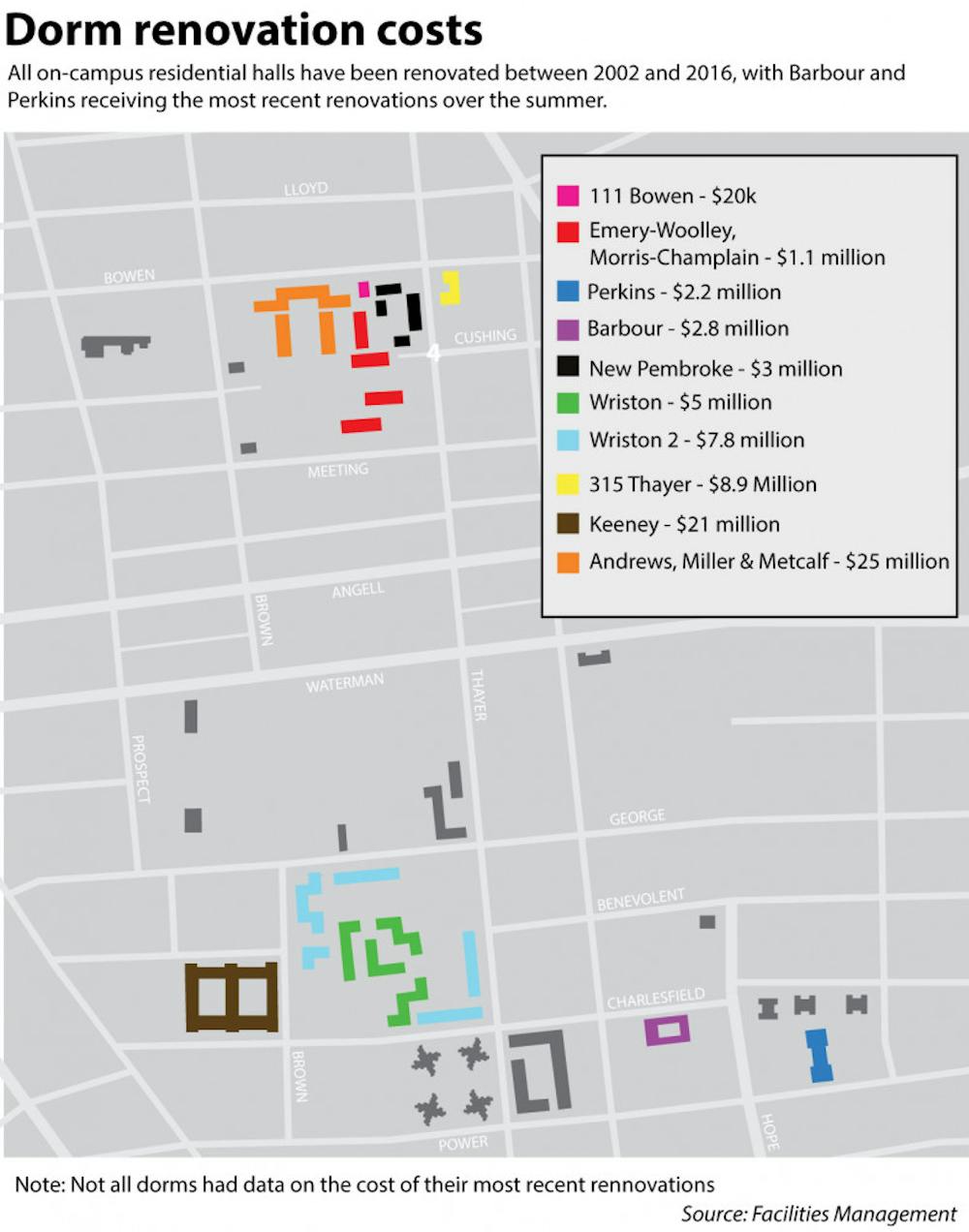As the new school year gets into full swing, students are beginning to settle into their new dorms on campus. With over 40 residential halls on campus, housing experiences at Brown can range from cinderblock walls to gorgeous views overlooking the Main Green.
Both the Office of Residential Life and the Department of Facilities Management are constantly looking for ways to improve the living experience at the University, said Vice President for Facilities Management Stephen Maiorisi.
“From 2012 to 2016, the University invested $90 million in residence halls,” Maiorisi added.
Much of the work occurs in various cycles, he said. Items like paint and carpets are refurbished more often than elements like the roofs and walls of residence halls, he added.
“We would not expect students to see all of this,” said Assistant Vice President for Campus Life Marylou McMillan, referring to the structural upgrades that may go unnoticed, yet are vital to the upkeep of residence halls.
This includes crucial upgrades to building safety like the “Fire Life Safety Upgrades” in which new fire prevention systems — such as sprinklers and fire alarms — were installed in all residential halls in 2005, Maiorisi said.
The most recent renovations to residence halls came this summer, when Barbour Hall and Perkins Hall received $2.8 million and $2.2 million upgrades, respectively. Barbour houses 169 students while Perkins is home to 191 students, according to Facilities Management records.
The University considers all aspects of the residence hall when looking at renovations, McMillan said, adding that the outdoor courtyard in Barbour Hall was redone over the summer.
“I am really happy with my suite in Barbour,” said Callie Smith ’19, who lives in a five-person suite in Barbour. “People who lived in the building last year told me that some of the rooms were worn down, so I was surprised to see how nice the furniture and kitchen appliances were.”
Smith added that all the suites she had visited have a “ton of space” with nice couches and tables.
But for students in other dorms, amenities are not as desirable. Keeney Quadrangle underwent a massive $21 million renovation that took place in 2013, according to Facilities Management records. But Rock Hoffman ’20 — who lives in Archibald-Bronson in Keeney— found there to be a “lack of water pressure in the showers” as well as “hand dryers (that) have so little power, they are essentially useless,” he said.
Hoffman also found broken cabinets and window shades in his room, which were later replaced by Facilities Management, he said.
Other first-year dorms, including Emery Hall, Woolley Hall, Morris and Champlin, were treated to renovations in 2013 that cost a total of $1.1 million.
“I’d probably describe the condition of my dorm as decent,” Elyse Sauber ’20, a resident in Woolley Hall. “It’s livable and there’s nothing fundamentally wrong with the conditions, but the building is old and grimy. I wouldn’t have a problem with it if the other freshman dorms weren’t so nice.”
Sauber enjoys the location of Woolley Hall, but would rather be in a bigger space as she doesn’t “spend a ton of time in (her) room since it’s so small.”
While Sauber thinks the University is doing “a wonderful job” in maintaining the overall conditions of the freshman dorms, a lot of new students “would be happier if the University worked to make the discrepancy between certain freshman living spaces a little less drastic,” she added.
A part of the 2013 renovation of first-year residence halls included making some of the residential halls more accessible for all students. Elevators were added to Keeney, Miller Hall and Metcalf Hall, McMillan said, adding that improving the accessibility of residence halls is one of the key areas looked at in determining how to conduct renovations.
Yet 30 percent of the residential halls remain inaccessible, Maiorisi said. For example, in the Young Orchard residence halls, only one room out of the three buildings is accessible to students with disabilities, Maiorisi said.
The accessibility of certain dorms can vary based on the specific floor. For instance, the dorms on Wriston Quadrangle — which were subject to two sets of renovations totaling $12 million over 2014 and 2015 — are only fully accessible on their first floors, with lifts and ramps available for wheelchairs. But without elevators, the dorms are not fully accessible, McMillan said.
Because the University guarantees on-campus housing to undergraduates for all four years with a requirement that first-year and sophomore students must live on campus, the Office of Residential Life must constantly deal with the issue of overcapacity. Though the University has a total of 5,021 beds across residential halls, and juniors and seniors have the option to live off-campus, some students find themselves in temporary housing, making their homes in former kitchens and lounges.
“This has been an average year in terms of overcapacity,” said Richard Hilton, associate director for administrative services at ResLife. About 16 students lived in temporary housing at the beginning of the new school year, though some of those students are now in permanent rooms, he added.
Students who take a leave of absence or do not inform the University they are not coming back for the semester provide opportunities for permanent rooms for those in temporary housing, Hilton said. Because of this, overcapacity “waxes and wanes “throughout the year, McMillan said. “We are always looking to increase capacity and looking at different options.”





